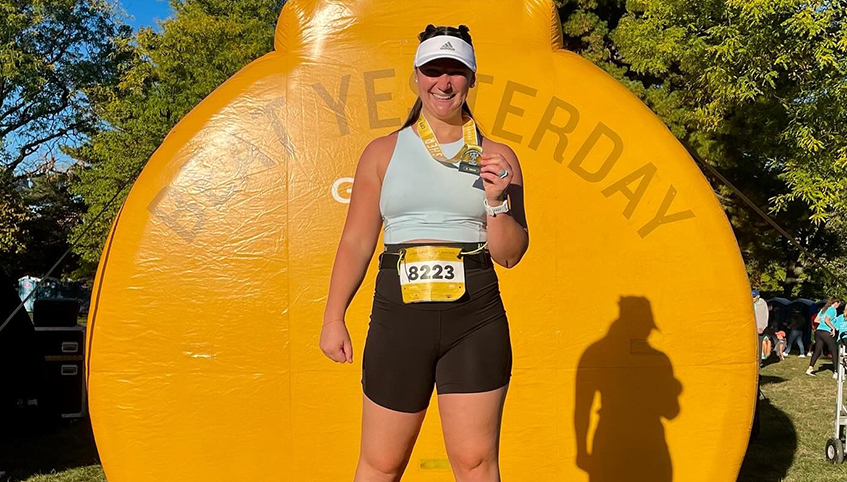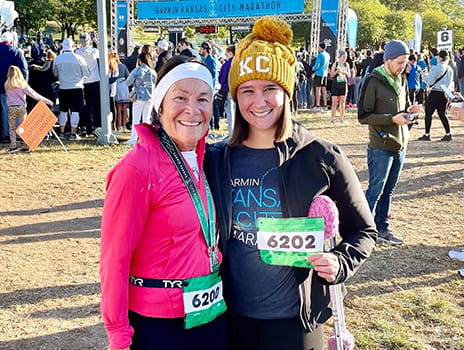January 19, 2024
It might be fair to say that Emma Stiles doesn’t have an off switch.
From 10 years of competitive gymnastics to collegiate diving and now competing in triathlons, the 27-year-old Kansas native has always been incredibly active. But her athletic career has had some breaks along the way – literally.
Emma’s gymnastics career ended in high school after a spinal stress fracture. The injury led to her switch to diving, since it utilized many of the same skills. She went on to be a Division I diver at the University of Massachusetts. But after college, she came to the realization that diving wouldn’t be a sport she could do for the rest of her life, and she wanted to continue being active.
“My best friend had done a triathlon, so I thought it would be fun to give that a try,” Emma says.
The fact that she hadn’t swum, biked or run long distances competitively didn’t stop her. Her dad is a cyclist, so she used his expertise to get started biking. Her husband was a collegiate swimmer, so he gave some advice to Emma on that portion.
“I had someone in each area to give me tips and pointers on how to slowly build myself up,” Emma says. “But it was really tough because all my sports were quick bursts of energy. I had to ease into it, and I don’t like to ease into things. I like to just go full force.”
That might be why after a training session in June 2022, Emma found she couldn’t put any weight on 1 leg. As a physical therapist, Emma diagnosed herself with a strained muscle or a torn labrum, at worst.
“So I kept training, “she says. “I brushed it off. I told myself: Everybody does things with a torn labrum.”
Emma ran her triathlon in July 2022 and then transitioned to training for a 10K in September. A few weeks before the race she finally visited a doctor at the health system’s Indian Creek location in Overland Park. The real problem was finally identified – a stress fracture in her leg. Emma was put on immediate, total rest just 3 days before she was scheduled to run her 10K.
Then her experience as a PT kicked in again. As a student, she had worked with Dana Young, PT, DPT, at the health system. On Young’s recommendation, she scheduled an appointment with a sports medicine specialist and was referred to Lisa Vopat, MD, who leads the health system's Female Athlete Program.
What is the Female Athlete Program?
According to Dr. Vopat, the Female Athlete Program is care provided by a multidisciplinary team. There are doctors, nurses and physical therapists who provide medical care as well as a sports dietitian and a sports psychologist to round out the holistic care offered through the program.
Furthermore, all the clinicians provide care with a unique understanding of female athletes. Dr. Vopat explains this is important because many general recommendations – for nutrition, sports medicine and more – are not representative of women.
“Females represent only about 39% of participants in our research studies,” says Dr. Vopat. And sometimes the number isn’t even that high. “For example, they just did an audit looking at what athletes should be doing in terms of their carbohydrate intake; females were only 11% of the participant pool.”
The Female Athlete Program overcomes these challenges by applying their specific understanding of women athletes and individualizing care. Dr. Vopat said she isn’t just treating injuries, she is assessing each person for underlying risk factors in things like their biomechanics, nutrition, sleep, mental state and more. The result is not only recovery but future injury prevention and improved performance.
“I thought it was really cool that all of them work really closely together,” Emma says. “I love that type of care because I think that it really embraces the full recovery rather than missing out on 1 key component.”

Putting the pieces together to get back in the race
However, Emma says, initially, the recommendation to work with a dietitian and psychologist had her a little skeptical.
“After I thought about it, it seemed like a good idea because what led to my injury was a really long history of sports that were aimed at perfection. And so, I think the dietitian side took care of some of the not-so-good eating habits that I maybe had gotten into with gymnastics and diving. And then sports psychology kind of helped me work through my thought process of why I was not fueling my body enough or why was I not listening to my body when I needed to take a break,” Emma says.
Young explained that a focus on nutrition is also essential to her work in physical therapy.
“When I have an athlete that's had a stress fracture, for example, I really need to make sure that they're on track with [dietitian] Sara Arnold. I can't start progressing their activity if they're not making those gains on the nutrition side, because we're going to be in the exact same spot that we were in before. I hate to do it this way, but sometimes I have to hold that back from them. We're not going to start running until we've figured out some of these nutritional concerns on Sara's end as well.”
In Emma’s case, recovering from the stress fracture meant a lot of time without putting weight on her leg. That’s when she started to focus on nutrition.
“When I was working with Sara, she would tell me, ‘OK, you're going to eat this many cups of rice.’ And I was like, ‘Are you kidding me? That was how much rice I ate in a whole week. You're telling me I have to eat that in a day?’ So now I always tell people, you have to eat more than you think,” Emma says.
Young also said that while Emma was on crutches, she did a lot of work building up stability and strength in her hip and core. That way, when it was time to start walking normally again, she could move into training to run easily. She said Emma’s recovery went as expected.
“There’s always going to be hiccups,” Young says. “Therapy is not linear, so Emma started training and found she was too strong in some patterns and not strong enough in others. So we had to fix some of that patterning.”
One year after her first triathlon, and after months of work with the Female Athlete Program, Emma competed in her second triathlon. And she didn’t just finish the race – she qualified for nationals.
“I'm new to triathlons, and I'm not the fastest runner by any means. But I set some goals, and I met most of my goals,” Emma says. “I was really happy that I was able to compete and have no pain. That was really the biggest thing.”
While being pain-free might seem like a minor thing, it is a big difference for Emma both physically and mentally.
“I think pain sometimes gets forgotten about in some of these athletes,” says Young. “Emma’s very competitive, and she grew up in a culture that said, ‘Ignore the pain – you have to compete.’”
And that might be the biggest lesson Emma has learned and wants to share with other female athletes.
“I want to tell people that you need to listen to your body, and it's not always about how you look, it's about how you feel,” Emma says. “I really do think it's important that if you're feeling tired, if you're feeling fatigued, you need to listen to that. And if you don't know what to do, seek out care to help you get on the right track so that you don't get an injury or get into a situation like I was.”
With 2 races and a full recovery completed in 2023, Emma is now looking forward to competing in 4 triathlons next year. She just keeps going.





